Alocasia Regal Shield makes a stand out focal point for a large, well lighted area of your home. This show stopper can also live happily on a summer patio with bright INDIRECT light.
The regal shield plant is commonly known as Elephant Ear due to its large leaves. However, don’t confuse it with the Gigantic colocasia Elephant Ear.
They are similar in appearance but the regal shield grows only to about 4 to 5 feet. Its leaves grow to 20 inches in diameter rather than the Gigantic size(three feet or larger) of the Elephant ear leaves.
This stunning large leaved plant can grow up to four feet tall which is considerably shorter than the Colocasia and the foliage is darker.
Regal shield has beautiful dark leaves with bright green veining courtesy of its Black Velvet Parent.
Set this statement plant in a large open area of your home away from open doors and windows, drafts or temperature changes.
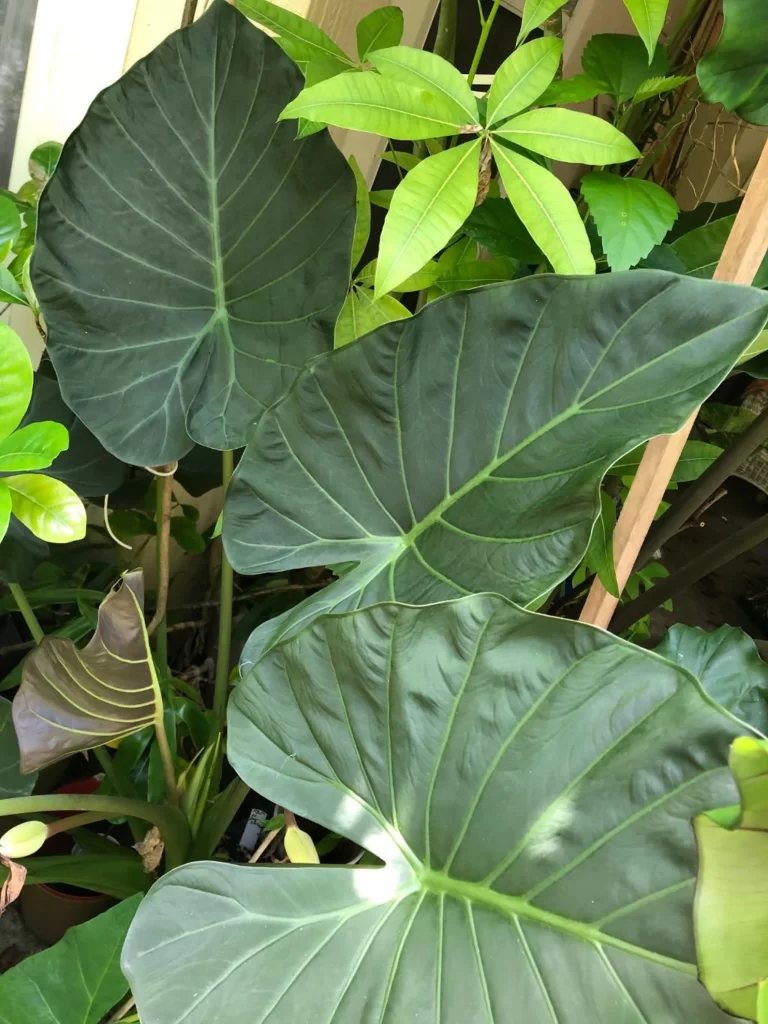
To ensure your plant baby is getting humidity, group it together with other plants. They will respire and breathe causing humidity to increase.
Origins and Description:
This beautiful elephant ear is a cross between the smaller dark leaved Alocasia Black Velvet and the Large leafed Alocasia Odora.
These plants are in the Araceae plant family. All alocasias are aroids native to southeast Asia and Eastern Australia.
Like other Alocasias, the regal shield is a good candidate to grow in LECA . When water propagated like a Pothos; a stem cutting can be grown semi hydroponically.
Otherwise propagation is by division of the corm. Divide and repot in the early spring or summer when the plant is waking up from winter dormancy.
Shop Alocasia Regal Shield On Etsy!
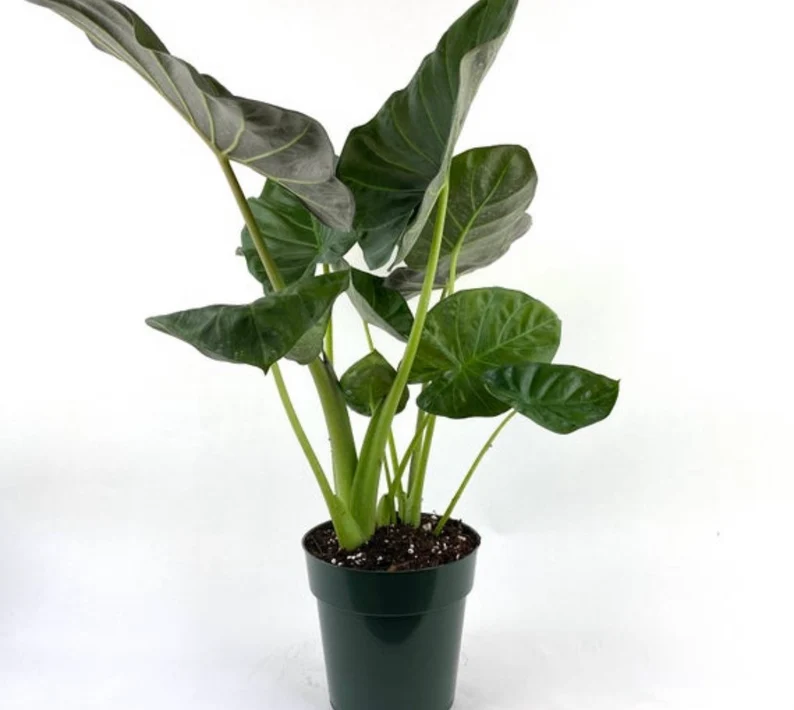
Air Filtering Plant:
This is an air filtering Plant. The large leaves will create oxygen in your home and filter out toxins as well.
NASA included this plant on its list of air filtering plants in the famous study. Learn more about air filtering Plants in this post.
Alocasia Regal Shield Flowers:
Like other alocasias, the Peace lily and Anthuriums, the regal shield flowers on upright growing stalks called a Spadix. The flowers grow out the top.
Regal Shields flower in spring and early summer. The flowers can be left on and enjoyed if you like them. It won’t hurt the plant.
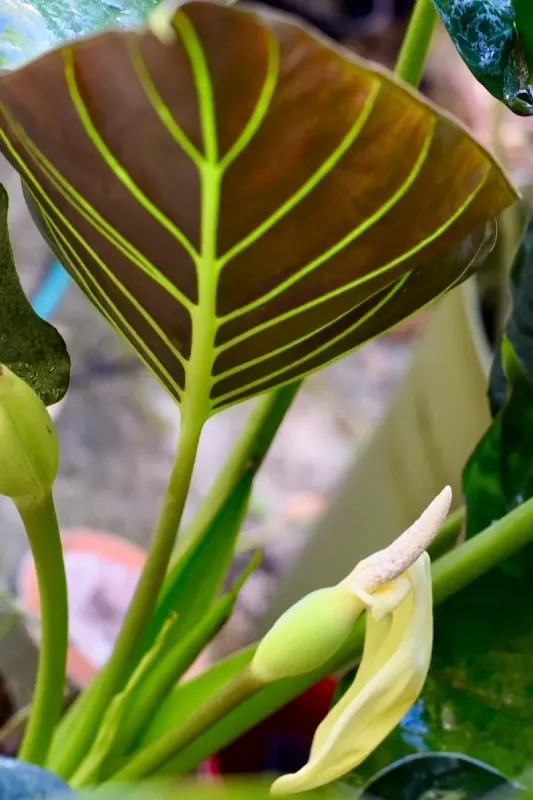
However, if the plant is suffering from stress removing the flowers may be one way to help it concentrate its energy to saving the plant rather surviving through making new seeds.
Alocasia Regal Shield Care:
This large leafy plant is not too difficult to care for IF you can give it what it needs. Bright indirect light, warmth and humidity. And NOT too much water around its roots.
The regal shield, like many tropical evergreen plants, REQUIRES humid, warm and mostly stagnant air.
Alocasia Regal Shield Care Guide
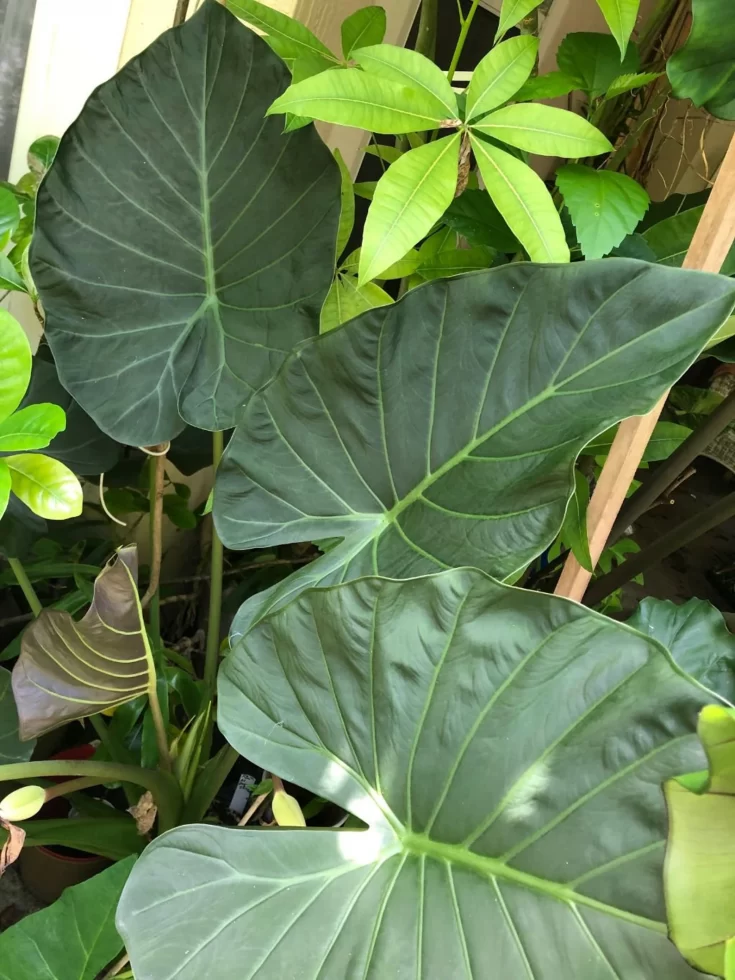
Elephant Ear Alocasia Regal Shiled is a stately tropical plant. Like the Colacasia Elehant Ear Plant, the Regal Shield needs LOTS of room, bright indrect light and warm humid growing conditions to be happy.
This eye catching plant grows as a large bush with tall stems and huge leaves. The varieties usually reach 4 feet tall and wide in a planter. Leaves can be as much as 20 inches across.
This Care Guide will teach you how to keep this plant happy all through the year.
Tools
Instructions
Soil Preference:
- This plant requires a rich well draining soil mix. Elephant ears LOVE and require lots of water. BUT they cannot have constant wet roots. That encourages root rot in containers.
- A mix of potting soil, succulent soil mix and orchid soil mix (look for one with a lot of peat and finer bark mix) will keep the roots happiest.
- Two parts potting soil to two parts succulent mix to two parts orchid bark.
- A heavy soil potting mix is not recommended for this plant.
Pot Size and Type:
- Alocasia regal shield needs containers that fit the root size.
- Any NON porous well drained pot can be used. It MUST have a drainage hole. Terra cotta wicks away water so keep an eye on watering if you use these pots.
- Repot every second year or when roots come out the drainage holes on the pot bottom.
- Repot to only the next size pot. DONT put the corm into a large pot. The extra soil will retain too much water for the roots and rot them.
Lighting:
- Regal Shiled requires bright indirect light
- Shield this plant from strong direct light in summer south and west sunny windows. The leaves will burn.
- Tip: Window sheers or blinds can offset some brief periods of high direct light.
Watering:
- Try a watering schedule of every week. Water thoroughly until the water runs out of the pot.
- Allow the regal shield to dry almost completely bewtween waterings depending on soil conditions. Well draining soil will allow you to water more often but this plant will get Root Rot is allowed too much moisture around it's corms.
- Watering is best done on a regular schedule so the plant is not over or under watered. Both can cause stress on the plant.
- Never let this plant get wet feet.. If the soil is compacted the bottom of the soil can remain wet which encourages root rot and fungus gnats.
Humidity:
- Regal shields need humidity. Set the container on a pebble tray with water under the pot or provide a humidifier to this tropical plant for best growth and happiness.
- Do NOT mist the leaves of this plant. It will encourage leaf diseases.
- Make sure you are not keeping your Regal Shield next to a heat or air vent. This will dramatically lower the humidity level and they will suffer.
How to Fertilize:
- Regal Shields require regular fertilizing.
- Apply a good quality fertilizer (linked in materials) monthly through Spring and summer.
- Alternately you can use a slow release fertilizer at the beginning of the growing season.
- Decrease feedings by late Fall and allow the elephant ear to rest through the winter months.
Temperature:
- Keep this plant at a low of 60 Degrees F. to upward of 85 Degrees F. It enjoys warmth and humidity.
Pests:
- Alocasia regal shield can be attacked by pests
- Stress by longterm overwatering, poor light, extreme temperatures and soil conditions are contributors to plant stress.
- Spider mites, mealy bugs, scale, thrips and whitefly are the most common houseplant pests you will see.
- Read our post on How to get rid of aphids and other pests with our homemade pesticide soap recipe or neems oil.
- To minimize the possibility of pests be sure to check all nursery plants before bringing them home.
- Quarantine all new plants until you are sure no pests live in them.
How to Propagate:
- This plant is easily propagated through bulb division.
- When you repot the elephant ear look at the bulb (corm). If you see it has grown a new corm off to the side gently pull the corms apart.
- Replant each corm into new soil and a separate pot.
Toxicity:
- Toxin- insoluble calcium oxalates. Keep this plant away from dogs, cats and horses. It is also toxic to humans.
- While not usually fatal, eating the raw leaves, stem and corm causes oral irritation, pain and swelling of mouth, tongue and lips, excessive drooling, vomiting (not horses), and difficulty swallowing.
Related Content
Follow Us:
Find us on YouTube, Instagram , Pinterest and TikTok! We love to Plant chat. We also comment, like and occasionally share your content to our daily stories. We’d love to see your plants. Share your joy in your houseplants. Happy Planting!
Recent Posts:
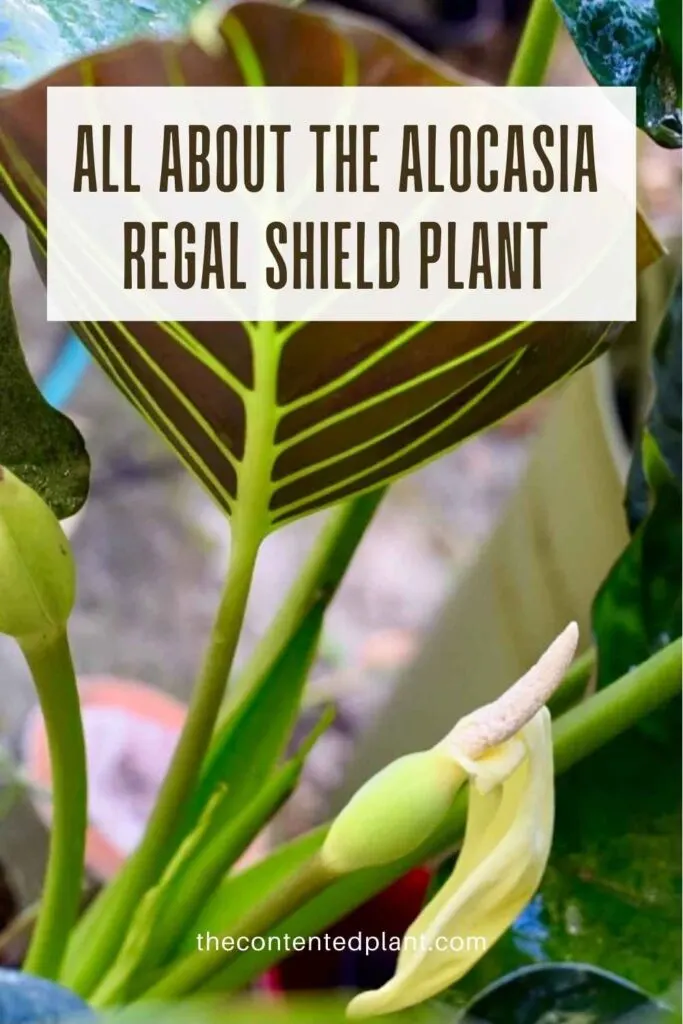
Further Reading on lively root and Gardeningit.com

